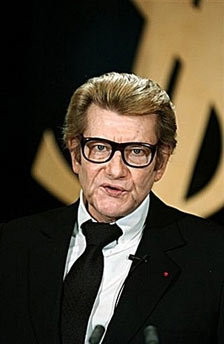AFP
Jun 1, 2008
Fashion giant Yves Saint Laurent dies at 71
AFP
Jun 1, 2008
 Yves Saint Laurent in 2002 - Photo : Eric Feferberg/AFP |
Saint Laurent, whose black trouser suits and safari jackets became an icon of women's liberation in the 1960s, died late Sunday of a brain tumour, his former lover and longtime business partner Pierre Berge said.
He had suffered poor mental and physical health for much of his life and had been seriously ill "for a year," Berge told French radio. The funeral will take place Friday in Paris.
The reclusive designer retired from haute couture in 2002 after four decades at the top, designing for French actress Catherine Deneuve and using supermodels such as Jerry Hall and Laetetia Casta to show off his clothes.
French leaders and fashion chiefs hailed Saint Laurent as a fashion revolutionary.
"One of the greatest names of fashion has disappeared, the first to elevate haute couture to the rank of art," said French President Nicolas Sarkozy.
"Yves Saint Laurent infused his label with his creative genius, elegant and refined personality, discreet and distinguished, during a half century of work, in both luxury and ready-to-wear, because he was convinced that beauty was a necessary luxury for all men and all women," Sarkozy said in a statement.
Berge said Saint Laurent "knew perfectly well that he had revolutionised haute couture, the important place he occupied in the second half of the 20th century".
"Yves St Laurent invented everything, revisited everything, transformed everything to the service of a passion, to let woman shine and to free her beauty and mystery," said Francois Pinault, head of the PPR fashion empire in a statement.
During his farewell in 2002, Saint Laurent said he had "always given the highest importance of all to respect for this craft, which is not exactly an art, but which needs an artist to exist."
One of a handful of designers who dominated 20th century fashion -- with Christian Dior, Coco Chanel and Paul Poiret -- Yves Henri Donat Mathieu Saint Laurent was born in Oran, Algeria, on August 1, 1936, when the North African country was a still French territory.
A shy, lonely, child, he was taunted over his homosexuality and became fascinated by clothes. When he first arrived in Paris in 1953, aged 17, he already had a solid portfolio of sketches.
Vogue editor Michel de Brunoff, who became a key supporter, was quickly won over, and published the images.
The following year Saint Laurent won three of the four categories in a design competition in Paris -- the fourth went to his contemporary Karl Lagerfeld, now at Chanel.
De Brunoff advised Christian Dior to hire him and he rapidly became heir apparent to the great couturier, taking over the house when Dior died suddenly three years later.
However in 1960, Saint Laurent was called up to fight in his native Algeria, where an independence war was under way.
Less than three weeks later he won an exemption on health grounds, but when he returned to Paris Dior had already found a replacement for him, Marc Bohan.
With his associate Berge, Saint Laurent resolved to strike out on his own, with Berge taking care of the business side.
Saint Laurent's success lay in the harmony he achieved between body and garment -- what he called "the total silence of clothing."
He was also in the right place at the right time. He founded his own couture house at the start of the 1960s, at a time when the world was changing and there was a new appetite for originality.
Saint Laurent rode his luck through the rise of the youth market and pop culture fuelled by the economic boom of the 1960s, when women suddenly had more economic freedom.
His name and the familiar YSL logo became synonymous with all the latest trends, highlighted by the creation of the Rive Gauche ready-to-wear label and perfume, as well as astute licensing deals for accessories and perfumes.
Throughout the 1960s and 1970s, he set the pace for fashion around the world, opening up the Japanese market and subsequently expanding to South Korea and Taiwan.
But Saint Laurent's career was not without controversy. In 1971 a collection modelled on the styles of World War II Paris was slammed by some American critics, and his launch in the mid 1970s of a perfume called "Opium" brought accusations that he was condoning drug use.
For fellow-designer Christian Lacroix, the reason for Saint Laurent's success was his astonishing versatility. There had, Lacroix said, been other great designers but none with the same range.
"Chanel, Schiaparelli, Balenciaga and Dior all did extraordinary things. But they worked within a particular style," he explained. "Yves Saint Laurent is much more versatile, like a combination of all of them."
In his later years the depression that had haunted him all his life became more oppressive, and at his farewell bash in 2002 Saint Laurent admitted to having recourse to "those false friends which are tranquillisers and narcotics."
Copyright © 2024 AFP. All rights reserved. All information displayed in this section (dispatches, photographs, logos) are protected by intellectual property rights owned by Agence France-Presse. As a consequence you may not copy, reproduce, modify, transmit, publish, display or in any way commercially exploit any of the contents of this section without the prior written consent of Agence France-Presses.

























